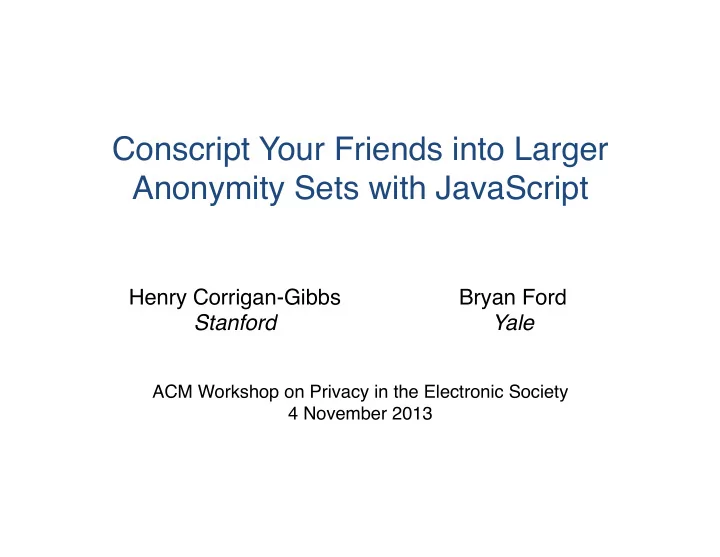

Conscript Your Friends into Larger Anonymity Sets with JavaScript � Henry Corrigan-Gibbs � Bryan Ford � Stanford � Yale � � ACM Workshop on Privacy in the Electronic Society � 4 November 2013 �
New Anonymity Systems Have a “Chicken-and-Egg” Problem � Small Few anonymity users � sets �
Adversary could just arrest all three participants � Overthrow the regime!! � Start the revolution!! � Emacs rulz!! �
Overthrow the regime!! � Start the revolution!! � ?? � Emacs rulz!! �
Idea � • “Conscript” casual Internet users into an anonymity system using JavaScript � – Casual users submit null messages � – Savvy users use a browser plug-in to swap out the null messages with real ones � • Compatible with a number of existing anonymity systems �
Outline � • Motivation � • Architecture � • Attacks and Defenses � • Evaluation �
GET /index.html � <html><script>... � E 1 (E 2 (E 3 (000))) � 000 � Using a randomized encryption scheme �
GET /index.html � <html><script>... � m � E 1 (E 2 (E 3 (000))) � 000 � Plugin � m � E 1 (E 2 (E 3 ( m ))) �
The Adversary Sees �
The Adversary Sees �
The Adversary Sees � Start the revolution! � 00000000 �
Security Property � IF � � Casual users’ messages indistinguishable � � � from savvy users’ messages � THEN � Conscripting increases the size of � � � the savvy users’ anonymity set � ≈ ¡ Casual � Savvy �
Compatible Anonymity Systems � 1. Monotonic anonymity set size � 2. Possible to simulate traffic streams � 3. Easy to identify malformed messages � � Yes : Timed mix cascade, verifiable shuffles, � remailers (maybe), verifiable DC-nets � No : Tor, batching mix net �
The ConScript Script � E.g., for a mix-net � • The JavaScript application sends � – RSA encryption routines, � – server public keys, and � – code to POST ciphertext to mix-server. � • Mix servers uses � � Access-Control-Allow-Origin header �
Outline � • Motivation � • Architecture � • Attacks and Defenses � • Evaluation �
Threats � Vulnerabilities of the underlying anonymity Web server can serve system � malicious JavaScript � User can submit incorrect messages �
JavaScript Attack � Plugin only swaps out msg if scripts match exactly � Plugin �
More Attacks � • Side-channel attack � • Selective DoS attack (“trickle attack”) � • Distribution point monitoring � – Who downloads the plug-in? � • User-counting attack � • […] � � Even if adversary can distinguish: Anonymity provided ≥ | Savvy users | �
Outline � • Motivation � • Architecture � • Attacks and Defenses � • Evaluation �
Proof-of-Concept Evaluation � Time (ms) to generate a dummy message on different devices. OpenPGP.js for RSA encryption, SJCL for ECC. � Verifiable � Device � Mix-net � DC-net � Workstation � 81 � 156 � Laptop � 133 � 231 � iPhone 4 � 9 009 � 62 973 � Milestone � – � 63 504 �
Related Work � • AdLeaks [Roth et al., FC‘13] � – Similar idea: JS for dummy messages � – Works with one particular anonymity system � – Vulnerable to active attacks by browsers � • FlashProxy [Fifield et al., PETS‘12] � – Use JavaScript to “conscript” browsers into acting as Tor bridges � • Bauer [WPES ‘03] � – Covert channel between mix servers �
Conclusion � • Conscripted anonymity is one possible way to address the chicken-and-egg problem in online anonymity � • Ongoing work on in-browser crypto could have benefits for anonymity systems too � – e.g., W3C Crypto API standard �
� Questions? � Henry Corrigan-Gibbs � henrycg@stanford.edu � � Thanks to David Fifield and David Wolinsky for their comments. �
Recommend
More recommend